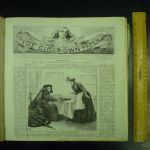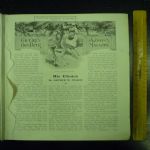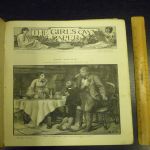| Girl's Own Paper, The; a paper for young women and their mothers. |
||||
| vol 1 no 1, 03 Jan 1880 - vol 29, 26 Sep 1908. then: Girl's Own Paper and Woman's Magazine. vol 30, Nov 1908 - vol 49, Dec 1927 then: Woman's Magazine and Girl's Own Paper. vol 50, Jan 1928 - vol 51, Sep 1930 then: Girl's Own Paper and Heiress, The. vol 52, 1931 - vol 62, Apr 1950 then: Heiress. May 1950 then: Heiress; the magazine for the older girl. Jun 1950 - 1956? London, Middlesex (1880 - 1849). Ed: Flora Klickmann (1907+); Charles Peters (1880 - 1907). Pub: Leisure Hour Office (1880). Printer: Judd and Co (1880); The Religious Tract Society; William Clowes and Sons Ltd (1900). Contributors: Henry Allon (Rev.); Thomas Archer; Mrs. Armytage; P. Atkinson (ill.); G. Linnaeus (Mrs.) Banks; Joseph Barnby; Anne Beale; Julius Benedict (Sir); Emma Brewer; Butterworth & Heath (1880); Sophia F.A. Caulfeild; Harriet L. Childe-Pemberton (1882); Alice Corcoran; William Cowen (Rev.); Josepha Crane (1895); George (Jr) Cruickshank (1880); George Cruikshank (ill. ); Elizabeth A.S. Dawes; Dora de Blacquiere; Eleonore d'Esterre-Keeling; Elsa d'Esterre-Keeling; Emily Dibdin; Cotsford Dick; Sainton Dolby (Madame); Sarah Doudney; Mary Ellen Edwards (ill.); Agnes Giberne; Kate Greenaway (ill.); Samuel Carter (Mrs.) Hall (pseud Anna Maria Hall); Arden Holt (1880); Annie Kemm; Alice King; Ruth Lamb; Norma Octavia Lorimer (1864 - 1948); James Macaulay; James Mason; Annie Matheson; Isabella Fyvie Mayo; G.K. Menzies; Anne Mercier; Fred. Miller (ill.); Gertrude Moberly; Edith Nesbit; F.A. Gord Ouseley (Rev. Sir); Fairleigh Owen; J.A. Owen; Edward Oxenford; Holden Pike; J. Pocock (1885 - 1886); M.M. Pollard; G.S. (Mrs.) Reany; Lemmens Sherrington; William Gordon Stables (pseudo "medicus"); John Stainer; Berthold Tours; George de Horne (Mrs.) Vaizey; Jetty Vogel; Helga Von Cramm (Baroness); F.S. Walker (ill.); Lily Watson; Harrison Weir; M.A. Whately; Edward Whymper; J.G. Wood (Rev.); Katherine F. Wright; Lucy H. Yates; Lambton Young. Size: 28cm, 14pp (Sep, 1880). Price: 1d/w, 6d/m (1894). Circulation: 250,000. Frequency: weekly; monthly. Illustration: music (1880); photographs, engravings (colour and b/w) (1900). Issued by: Religious Tract Society, The. Indexing: list of contributors/vol, index/vol, list of plates/vol, T of C/part (1880). Departments: serial fiction, poetry, more than coronets, acrostics, riddles, puzzles, answers to correspondents (1880); short stories, anecdotes, recipes, patterns, instructions for knitting, embroidering, dressmaking, dress: in season and in reason, amusement, sketching, music, recreations; useful hints, healthy recreations, moral virtues. Orientation: nondenomicational. Sources: Avery, Childhood’s Pattern.; Cadogan, Mary, and Patricia Craig. You're A Brick, Angela!. A New Look at Girls' Fiction from 1839 to 1975. London: Victor Gollancz Ltd, 1976.; Carpenter, Humphrey and Mari Prichard. The Oxford Companion to Children's Literature. Oxford, NY: Oxford UP, 1984.; COPAC; Dixon, Diana. "Children and the Press, 1866-1914". The Press in English Society from the Seventeenth to Nineteenth Centuries. Ed. Michael Harris and Alan Lee. London, Toronto: Associated University Presses, 1986: 133-148.; Egoff, Sheila A. "Children's Periodicals of the Nineteenth Century. A Survey and Bibliography." Library Association: Pamphlet. 8 (1951): 55.; Ellis, Children’s Reading and Literature.; Mitchell's.; Salmon, Edward. "What Girls Read." NC. 20 (1886): 520-523.; Sutherland Longman Companion to Victorian Fiction.; Uffelman, 1992.; White, Cynthia. Women's Magazines 1693-1968. London: Michael Joseph Ltd, 1970.; OLIS; Cantor, Science in the Nineteenth-Century Periodical .; Bashfor, Langley, Music and British Culture.; Frost, Ginger S. Victorian Childhoods. Praeger Publishers, 2009, p.1-168; Moruzi, Kristine and Michelle Smith. “’Learning what Real Work…Means’: Ambivalent Attitudes Towards Employment in the Girl’s Own Paper.” Victorian Periodicals Review. 43:4. Baltimore: John Hopkins Univ Press, 2010. pp.429-445; "Periodicals." Annual Report of The Religious Tract Society. 83 (1882), p.302.; Prince, Kathryn. Shakespeare in the Victorian Periodicals. Routledge, 2008, p.1-149; Sumpter, Caroline. The Victorian Press and the Fairy Tale. Palgrave Macmillan, 2008, p.1-178; |
Histories: Altholz, Religious Press in Britain.; Altick, English Common Reader.; Beetham, Domesticity and Desire.; Bingham, Jane and Grayce Scholt. Fifteen Centuries of Children's Literature. An Annotated Chronology of British and American Works in Historical Context. Westprot, Connecticut, London, England: Greenwood Press, 1980.; Cano-Lopez, "The Outlandish Jane." VPR, 47:2 (2014):255-273.; Doughty, Selections from The Girl’s Own Paper, 1880–1907, 2004.; Drotner, Kirsten. English Children and Their Magazines, 1751-1945. New Haven and Yale UP, 1988.; Forrester, Great-Grandmama’s Weekly.; Fox, "Victorian Girls' Periodicals and the Challenge of Adolescent Autonomy".; Harris, Michael and Alan Lee. eds. The Press in English Society. London: Associated University Presses, 1986.; Hindle, “Advice to Girls”.; King, Andrew and John Plunkett. Victorian Print Media: a Reader. Oxford: Oxford University Press, 2005.; Kortsch, Christine Bayles. Dress Culture in Late Victorian Women's Fiction. Farnham, England: Ashgate, 2009; Moruzi, "Children's Periodicals" p.298.; Moruzi, Kristine. Constructing Girlhood through the Periodical Press, 1850-1915, 2012.; Nelson, "Growing Up Childhood".; Rodgers, "Researching the Relationship Between Two Periodicals".; Petzold, "Ambiguities in Gender Genre and Representation".; Petzold, "Victorian Gendered Photography".; Sunderland, "Politics for Girls".; Uffelman p.49.; VPR 14:2, p.79-81, 14:2, p.80.; 16:2, p.74-75; 19:2, p.66; 40:3, p.225.; Walchester, "The Boundaries of Female Propriety in the British Periodical Press". Comments: Weekly issues were collected and published as Girls' Own Annual,. Advertised in The Artizan's Year Book and Engineers' & Building Trades' Almanack as "the magazine for young ladies" (1883). "The girls' magazines of the 1880s and 1890s were pioneered by the Girls' Own Paper (1880-1927), a penny weekly published by the Religious Tract Society as a companion publication to their Boys' Own Paper. The GOP, as it was known, rapidly gained a circulation of 250,000 and soon outstripped the boys' paper" (Beetham). It became "the most popular girls' magazine of the century" (Moruzi, "Children's Periodicals" 298). In the beginning, "the Girl's Own Paper was offering its readers domestic fiction, rather drab school stories and gentle anecdotes about the childhood of Queen Victoria...the G.O.P. addressed itself to both mistresses and servants. When Flora Klickmann succeeded Charles Peters as editor in 1908...she tried to bring a rather fey kind of charm to the Girl's Own Paper, as well as a wider and more imaginative range of illustrations. These often ran riot across pages of text quite unrelated to them, so that, for instance, an interview with Thomas Edison in 1914 is illustrated by photographs of frolicking kittens...however, the G.O.P. developed a slightly more forward- looking policy, reflecting the changing structure of Edwardian society" (Cadogan and Craig, pp.73-75, 80). "The Girl's Own Paper...which provided [maidens] with wholesome reading, catered for an age range of twelve to twenty-five. It is hardly surprising that the fiction that was supposed to cover the needs of them all should have pleased very few of them. The younger girls in particular wanted something with more life, and turned to their brothers' school and adventure stories" (Avery, Gillian; p.206). According to Drotner, "it was the express aim of the editor, Charles Peters, to cater not only to the young lady of the leisured classes, but also to 'girls of a less high position' who would receive instruction in 'economical cookery, plain needlework, home education and health.' Even servants should find in the magazine a guide 'to their humble work...a counsellor in sore temptation' and an advisor of 'a pure and honest life.' ...[S]tarted life as a weekly and subsequently became a monthly in response to readers' requests for a larger magazine with more illustrations. At first, fashion was conspicuous by its absence, but it was introduced later for the benefit of older women who apparently enjoyed the magazine as much as their daughters did, and asked for special features to be included for them" (White, Cynthia; p.72). "In 1884 [this paper] was said to have attained 'a circulation equalled by no other English illustrated magazine published in this country'" (Salmon, "What Girls Read", p.521). "[T]he Girl's Own Paper recognized that in order to displace the 'penny dreadful' the new periodical would have to ape some aspects of these lower publications" (Noakes, p.155). Of all comparable publications of its type, the Girl's Own Paper "marketed itself as crossing class boundaries and appealed to readers from a variety of backgrounds" (Rodgers 93). Published an article entitled "How to Live on 100 [Pounds] a Year" 09 Jan. 1886 (Kortsch, p.32). The "Girl's Own Paper nonetheless was open to wider spheres for women, catering both to the majority of girls who expected to become wives and mothers and the growing minority who sought education and careers" (Altholz 55). Location: partial runs: LO/N-1 A vols 1-51, 52-60, 52-62 (03 Jan 1880-Dec 1956 inc, wanting Oct-Dec 139 Woman's Magazine), QZ/P-1 vols 1-24, 40-48 (1880-1903, 1918-1927); OX/U-1 A (1880); Ulster Folk Museum; N.America: see Fulton, ULS 2&3; The full text is available on CENGAGE from Gale. |
|||





